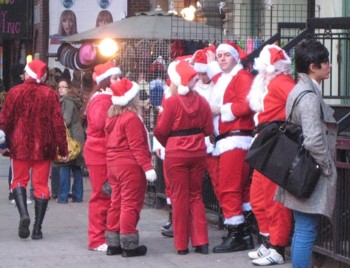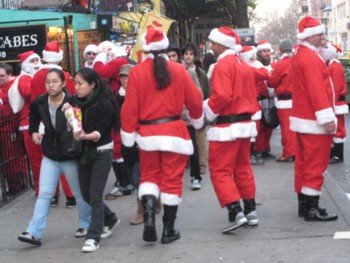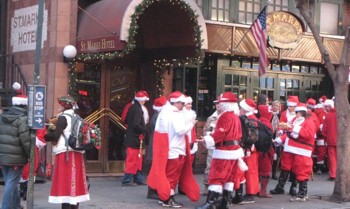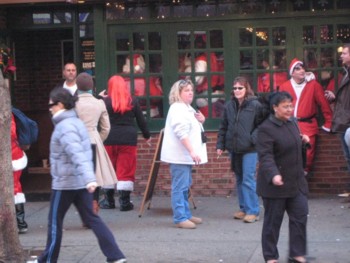
Santa Babies
One Saturday before Christmas after my merry rounds uptown, searching here and there in galleries for art rather than looking at art, I was on my way back to my East Village lair, when….
I was treated to the spectacle of multiple Santas. They were hanging out on historic St. Mark’s Place. This uncomely but vital boulevard, once the home of the Dom and Andy Warhol’s Plastic Floating Inevitable, is now a battleground between bustling tattoo parlors (Whatever Tattoo, Dots NY, et al.) and serenely empty, mostly Asian, supermodern fast-food franchises, looking like beta versions of concepts ready to take over the post-dining world: Good Dog, Very Berry, T Kettle, Pinkberry. BAM Automat is the exception. It’s a glistening stand-up with little coin-liberated windows offering slider-size burgers, corn dogs, macaroni and cheese, fried Spam, and the $2 grilled cheese sandwiches that are much too much my favorite grab.
The largest gaggle of Santas, however, was in front of a bar near Kim’s, my essential video provider. Santas not outside the saloon smoking were inside hoisting tankards of beer or throwing back the potent contents of shot glasses. It obviously takes a great deal of liquid reinforcement to parade around in a Santa suit in broad daylight. My digital at hand, I snapped away. I don’t know if this was before or after the Santas were instructed by text-messaging to dance their brains out further east in Tompkins Square, where once in the Roaring ’60s there was a Be-In.
I had experienced my first SantaCon, which is short for Santa Conference, the performance form that generated Flash Mobs. I have been so enthralled by the official art world — the scandals, the auctions, the cash piles and the career crashes — that I had remained blissfully unaware of SantaCons, or what I would prefer to call Santa Swarms. They are of suspicious origin, but apparently date back to 1994 and are arguably the precedents for Flash Mobs, which are even more suspect.
So once I found SantaConNYC on the internet I immediately hatched a plan to join up next year and, clad in Santa drag, as an Artopia spy, get the inside dope. Unfortunately, the august New York Times, ever ready to destroy new art by labeling it a trend, scooped me with “Naughty Santa Reveals All.” Well, not quite all. Is it really true that most SantaCon Santas have not met before? Has romance among Santas bloomed? Do you get to keep your Santa togs? Are there repeat offenders? Do any of the Santas know they are making art? And since Santa Conferences have been going on for at least 13 years, does Santa Swarming run in families? I also wonder if Kris Kringles participate in other Flash Mobs?
Once I started Googling, I couldn’t stop.
On the SantaCon website I count 65 official SantaCons this year: not only in New York and San Francisco, but also Asheville and Philadelphia. Not only in London, Munich, and Paris, but also Bangkok, Mumbai, and Phnom Penh.
If you still not have had your fill of Bad Santas, for more images and the full N.Y.C. itinerary go to this site.
There are now Zombie Mobs every year. This Flash Mob variant had its origin in San Francisco, that city known for its seriousness and good taste.
And Pillow Fight Swarms worldwide.

Nomenclature
The term Flash Mob has been around since 2003. That indisputable source of all factoids, Wikipedia, credits Bill Wasik (a senior editor of Harper’s Magazine!) with launching the first Flash Mob (according to Wasik himself), which seems to have involved getting hundreds of young men and women to go through the motions of purchasing an expensive rug at Macy’s.
Flash Mobs happen in a flash. They are inexplicable, so they are sometimes referred to as Inexplicable Mobs.
Not only are they public, anonymous and quick, they have to be senseless. Participants are instructed by e-mail, cell phones, or text-messaging.
What I dislike about the terms is not the “Flash” or the “Inexplicable,” but the “Mob.” It all sounds criminal and/or mindless, which may have been Wasik’s intention, since he seems to have wanted to make fun of disaffiliated youth or D. Y.’s on a spree.
Since most Flash Mob organizers insist on appropriate respect for persons and property, which is a good way to keep out of jail, I prefer the less negative Swarm and Swarming. But Mob, I admit, does have a certain Jimmy Cagney frisson.
Although they are mostly apolitical and do not involve igniting stuffed manikins, Flash Mobs may have a darker, historical origin: the Anglo-Saxon tradition of effigy-burning while dressed up in costumes, once adopted by unfairly treated tinsmiths, tailors, and the like, in pre-Draft Riot, pre-Santa New York City. I have been reading Sean Wilentz’s Chants Democratic: New York City and the Rise of the American Working Class (1788-1859) and found this toss-off reference to antebellum protest.
Nevertheless, no matter what the deeper genesis or whatever the nomenclature, SantaCon — at least in Artopia — is the origin of all Flash Mobs and Swarms, and not some editor of Harper’s. It is about time we gave the Santas their due.

Drop Till You Shop: It’s the Idea That Counts.
Another Christmas-appropriate art form is Shopdropping.
It is, as the clever name implies, the opposite of shoplifting. Handmade merchandise, replicas, and altered products are inserted next to the real things in stores to surprise, politicize and/or aestheticize the unwary shopper (or checkout clerk).
There has already been an exhibition of Shopdropping at the Pond Gallery in San Francisco in 2005.
Zoe Sheehan Saldana, upon the occasion of her show at real Art Ways in Hartford, had her 10 minutes of fame, courtesy of the N.Y. Times and the Philadelphia Inquirer. She made and inserted exact copies of Wal-Mart clothes, later exhibiting the originals along with photos of her facsimiles.

But Is It Art?
Are Swarms or Flash Mobs art? Well, they certainly allow the free play of signifiers and thus participation/co-creation by interpretation — both sure signs of modernism/postmodernism. Art historical anchors are Actions, Events, Happenings, Performances, Kusama’s nude street extravaganzas, or the more individualistic and elitist Street Works of 1969. However, a few cues are missing. Authorial attribution is scant. Signs of artistic intention, such as direct address of art media and art audiences, are virtually non-existent. So far there is nothing for sale. And luckily there has been no institutional ratification.
At this point, my feeling is that Swarms are closer to celebrations, pageants, and parades, than to signed art, but they are art in the largest, if not the highest, sense.
Well, I take that back. Why not highest? Like Mardi Gras floats, Halloween parades, Christmas lights, and roadside memorials, they are art of, by and for the people — in this case mostly young and cyber-savvy, not all of them male.
Little of this applies to Shopdropping, which is usually not collective. Although Shopdropping can be aligned to Appropriation Art, and like Swarms is seriously interventionist, the shopdropper is looking over his or her shoulder at the art world. I do not mean this as a condemnation, but as a description. Normal paradoxes therefore come into play and irony has its day.
When Flash Mobs swarm into stores and malls, they are not unrelated to Shopdropping. Context is all. An example would be the Shirtless Flash Mob, perpetuated by Charlie Todd’s ImprovEverywhere. On October 13, at Abercrombie & Fitch, Fifth Avenue, over 100 young men took off their shirts. Here we have an “author.” And we certainly have a critique of advertising and shopping.
Abercrombie is noted for its successful ads and photo-décor of hairless, bare-chested, gym-boys with perfect pecs. In the web-photos, the contrast between real guys and the homoerotic youths depicted in the Abercrombie campaign is telling. Unanswered, of course, is the question of why such depictions successfully sell clothes to young men of all persuasions. I guess for somewhat the same reasons that skinny fashion models sell clothes to women of all sizes. Who you REALLY are is not important, but who you want to be is what counts.
* * *

Shopdropping According to Jonathan Swift
Artists, I fear, have upon occasion Shopdropped their art into galleries and museums. Some are now wanted by the art police, some are in art jail, some are still getting away with it. I will not mention names.
In 1958, James Lee Byars (1932-97) debuted in New York City with a paperwork in an empty MoMA stairwell. Reportedly it only lasted a few hours and was approved by the highly respected curator, Dorothy Miller. Since it did not go through regulation channels and was unpublicized — but most likely went unseen by the public — is this an early example of Shopdropping?
And what do you with Giorgio de Chirico, who faked his own earlier work, “dropping” into the art market 18 backdated versions of his 1918 The Disquieting Muse? How do you handle a venerated abstractionist who delivered still-wet, freshened versions of his old paintings to his museum retrospective? Were these also just more sophisticated versions of Shopdropping?
Dots used to appear next to artworks. Red meant sold; half-a-red or a blue signified reserved. Now the truth can be told: some dots were fakes. This intervention — whether perpetrated by the artists themselves, gallerists, or strangers — must have gotten out of hand, because nowadays dots are nowhere to be seen. Maybe this is an effort to give art shops the aura once attached to museums.
I think the red dot system should be embraced again, but by art museums. Because exhibitions are expensive and government funding is scarce, most museums contract to keep a percentage of sales of artworks. In order to help museums with their bottom lines, I also suggest that price lists be readily available, just as New York State law requires of for-profit galleries.
FOR AN AUTOMATIC ARTOPIA ALERT WHEN NEW TEXTS ARE POSTED PLEASE CONTACT: perreault@aol.com
John Perreault's art diary
